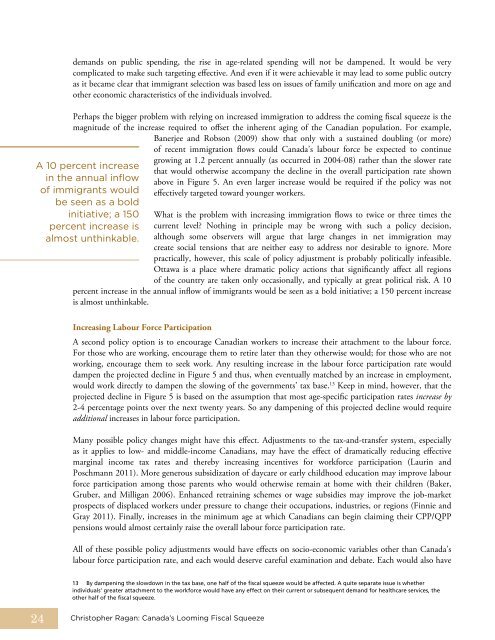Christopher Ragan, "Canada's Looming Fiscal Squeeze," November
Christopher Ragan, "Canada's Looming Fiscal Squeeze," November
Christopher Ragan, "Canada's Looming Fiscal Squeeze," November
Create successful ePaper yourself
Turn your PDF publications into a flip-book with our unique Google optimized e-Paper software.
A 10 percent increase<br />
in the annual inflow<br />
of immigrants would<br />
be seen as a bold<br />
initiative; a 150<br />
percent increase is<br />
almost unthinkable.<br />
24<br />
demands on public spending, the rise in age-related spending will not be dampened. It would be very<br />
complicated to make such targeting effective. And even if it were achievable it may lead to some public outcry<br />
as it became clear that immigrant selection was based less on issues of family unification and more on age and<br />
other economic characteristics of the individuals involved.<br />
Perhaps the bigger problem with relying on increased immigration to address the coming fiscal squeeze is the<br />
magnitude of the increase required to offset the inherent aging of the Canadian population. For example,<br />
banerjee and robson (2009) show that only with a sustained doubling (or more)<br />
of recent immigration flows could Canada’s labour force be expected to continue<br />
growing at 1.2 percent annually (as occurred in 2004-08) rather than the slower rate<br />
that would otherwise accompany the decline in the overall participation rate shown<br />
above in Figure 5. An even larger increase would be required if the policy was not<br />
effectively targeted toward younger workers.<br />
What is the problem with increasing immigration flows to twice or three times the<br />
current level? Nothing in principle may be wrong with such a policy decision,<br />
although some observers will argue that large changes in net immigration may<br />
create social tensions that are neither easy to address nor desirable to ignore. more<br />
practically, however, this scale of policy adjustment is probably politically infeasible.<br />
ottawa is a place where dramatic policy actions that significantly affect all regions<br />
of the country are taken only occasionally, and typically at great political risk. A 10<br />
percent increase in the annual inflow of immigrants would be seen as a bold initiative; a 150 percent increase<br />
is almost unthinkable.<br />
Increasing Labour Force Participation<br />
A second policy option is to encourage Canadian workers to increase their attachment to the labour force.<br />
For those who are working, encourage them to retire later than they otherwise would; for those who are not<br />
working, encourage them to seek work. Any resulting increase in the labour force participation rate would<br />
dampen the projected decline in Figure 5 and thus, when eventually matched by an increase in employment,<br />
would work directly to dampen the slowing of the governments’ tax base. 13 Keep in mind, however, that the<br />
projected decline in Figure 5 is based on the assumption that most age-specific participation rates increase by<br />
2-4 percentage points over the next twenty years. So any dampening of this projected decline would require<br />
additional increases in labour force participation.<br />
many possible policy changes might have this effect. Adjustments to the tax-and-transfer system, especially<br />
as it applies to low- and middle-income Canadians, may have the effect of dramatically reducing effective<br />
marginal income tax rates and thereby increasing incentives for workforce participation (Laurin and<br />
Poschmann 2011). more generous subsidization of daycare or early childhood education may improve labour<br />
force participation among those parents who would otherwise remain at home with their children (baker,<br />
Gruber, and milligan 2006). enhanced retraining schemes or wage subsidies may improve the job-market<br />
prospects of displaced workers under pressure to change their occupations, industries, or regions (Finnie and<br />
Gray 2011). Finally, increases in the minimum age at which Canadians can begin claiming their CPP/QPP<br />
pensions would almost certainly raise the overall labour force participation rate.<br />
All of these possible policy adjustments would have effects on socio-economic variables other than Canada’s<br />
labour force participation rate, and each would deserve careful examination and debate. each would also have<br />
13 By dampening the slowdown in the tax base, one half of the fiscal squeeze would be affected. A quite separate issue is whether<br />
individuals’ greater attachment to the workforce would have any effect on their current or subsequent demand for healthcare services, the<br />
other half of the fiscal squeeze.<br />
<strong>Christopher</strong> <strong>Ragan</strong>: Canada’s <strong>Looming</strong> <strong>Fiscal</strong> <strong>Squeeze</strong>





